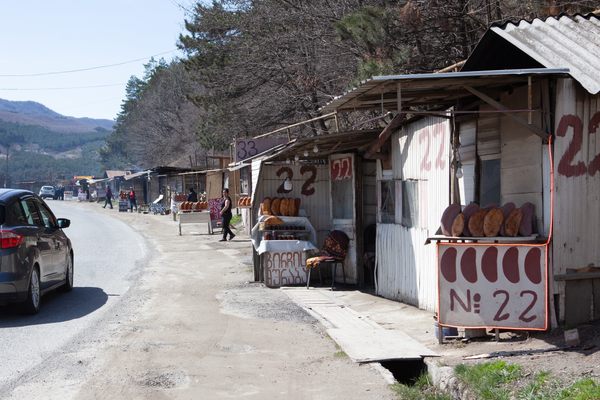
Around the World in 10 Sandwiches
A food everyone loves is also a dish almost every culture has made their own.
The sandwich is a very specific formula: two pieces of bread, something in between. But limitations can create fascinating innovations, and the global array of sandwiches are perhaps the best example of that. Some, as the list below shows, are finger foods, while others can barely be held in two hands. Here is just a small collection of some of the world’s most exciting, boundary-pushing, or surprising sandwiches.

Simit-Pogacha, North Macedonia
Simit-pogacha is a beloved breakfast food in Skopje, capital of the Republic of North Macedonia. Bakers slice open a bun, stuff it with burek—a pastry crust of layered phyllo—and serve it as a sandwich. While burek is often stuffed with other ingredients, this version has no meat, no cheese, no sauce. Just pastry.
Stuffed Camel Spleen Sandwich, Morocco
Among the chaos of the Fes medina’s winding pedestrian walkways, street vendors slice and sear sausage-like entities that appear kindred to massive haggises. These are pieces of camel’s spleen, loaded with ground meat, spices, olives, and preserved lemon. Traditionally, cooks pre-bake the stuffed, log-like loaf in one of Morocco’s many communal bread ovens until it turns a deep, dark shade, then fry slices to order. Medina vendors take rapid-fire requests, scrambling the stuffed spleen with herbs, vegetables, and sometimes (if you ask nicely) an egg, in about a minute. Then, they’ll scoop the mixture into open pockets of batbout, a type of Moroccan pita.

Fruit Sando, Japan
While the fluffy, white-bread exterior of Japan’s fruit sando might seem unassuming, its interior holds something special. Chunks of fresh fruit, such as strawberries, kiwi, and banana are suspended in a light, fluffy whipped cream between slices of shokupan, or Japanese milk bread. Special care is taken in assembling fruit sandos: Often, they are cut so precisely that the perfectly sliced and placed fruit shines against the background of cream and bread like panels of stained glass.
Donkey Burger, China
In the Chinese cities of Baoding and Hejian, buns stuffed with shredded donkey meat, sometimes referred to as “donkey burgers,” grace menus at fine-dining restaurants and street-side stalls alike. When it’s marinated and cooked for hours, donkey meat turns from sinewy to tender and sweet. Some cooks mix chunks of fat or green peppers into the naturally lean meat, creating a uniquely textured, flavorful sandwich. All that gets stuffed into warm, flaky buns—round in Baoding and rectangular in Heijan.

Lapredotto, Italy
Cruise along the cobblestoned streets of Florence, and you’re bound to bump into a trippai kiosk, where vendors preside over steaming pots of tripe boiling with vegetables and herbs. Order the classic lampredotto panino, and you’ll receive a crispy bun piled with tender slices of meat from a very particular part of the cow: its fourth stomach. Most lampredotto sandwiches come drizzled with a parsley-and-garlic-based green sauce and chili-infused olive oil. The preferred panino presentation is bagnato, or “bathed,” in which the upper bun is dipped in tripe broth and perched, warm and moist, atop lunch.
Sánguche de Potito, Chile
On game days in Santiago, many fútbol fans can be seen biting into a sánguche de potito. The popular street food is a rich, chewy sandwich served inside a marraqueta bun and filled with fried onions and meat from the rectum, or sometimes intestine, of a cow. After cooking the meat until it’s juicy and soft, vendors mix it with fried onions, then slide both into the bun and top it with condiments such as ketchup, mayonnaise, chilis, or pebre (Chilean pico de gallo).

Flaeskesteg, Denmark
In Denmark, the flæskesteg sandwich—also known as the flæskestegssandwich—is a Christmas special. Its primary filling is the popular holiday meat known as flæskesteg, roast pork cooked so that its top layer of fat bubbles and crisps up, forming a salty, crackling crust. To make the signature sandwich, vendors slice the roast and layer it atop a remoulade-coated burgerboller (a hamburger-type bun), along with a colorful combo of cooked red cabbage and pickled cucumbers.
Francesinha, Portugal
Served as a gooey, heaped mound in a pool of slightly spicy sauce, the francesinha is a sandwich only by the definition that it contains meat between bread. Your typical francesinha contains cured ham, steak, and linguiça (a Portuguese sausage) stashed between thick slices of bread. Coating the sandwich are layers of melted cheese and a secret sauce that contains beer, tomato, chilies, and, apparently, even more meat. If that’s not enough, you can add a runny egg on top and a side of french fries for dipping.

Chop Suey Sandwich, Massachusetts
According to the New England Historical Society, this sandwich was developed around 1875 by Chinese immigrants who wanted to infuse a local snack with the flavors of home. It consists of roast chicken or pork sautéed with celery, onions, and bean sprouts in a soy gravy, and is served in a hamburger bun, often with a fork.
Savoury Slice in a Flat Roll with Sauce, Australia
In South Australia’s Murraylands region, there’s a little-known pastry that’s attracted a passionate cult following: the savoury slice. To make it, cooks glue two pastry sheets together with a layer of meaty gravy, then cover one side with cheese and bacon before throwing the pizza-like creation into the oven. Decades ago, kids at one of the town’s many public schools invented a “right way” to eat the slice: Upgrade your experience by sliding the cheese-and-bacon-coated pastry into a flat buttered bread roll with a coating of tomato sauce.

















Follow us on Twitter to get the latest on the world's hidden wonders.
Like us on Facebook to get the latest on the world's hidden wonders.
Follow us on Twitter Like us on Facebook